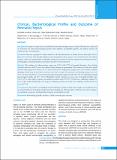Please use this identifier to cite or link to this item:
https://hdl.handle.net/20.500.14356/2309| Title: | Clinical, Bacteriological Profile and Outcome of Neonatal Sepsis |
| Authors: | Siwakoti, Shraddha Sah, Rinku Singh, Rupa Rajbhandari Khanal, Basudha |
| Citation: | SiwakotiS., SahR., SinghR. R., & KhanalB. (2023). Clinical, Bacteriological Profile and Outcome of Neonatal Sepsis. Journal of Nepal Health Research Council, 20(4), 967-972. https://doi.org/10.33314/jnhrc.v20i4.4381 |
| Issue Date: | 2022 |
| Publisher: | Government of Nepal; Nepal Health Research Council; Ramshah Path, Kathmandu, Nepal |
| Keywords: | Bacteriological profile Incidence MDR Neonatal sepsis Outcome |
| Series/Report no.: | Oct-Dec, 2022;4381 |
| Abstract: | Abstract Background: Sepsis is a major cause of morbidity and mortality among neonates in Nepal. This study was conducted to determine the clinical-bacteriological profile, their antibiotic susceptibility patterns, and clinical outcome of culture-positive neonatal sepsis. Methods: This was a prospective study conducted at B.P Koirala Institute of Health Sciences from July 2018 to June 2019. Neonates with clinically diagnosed sepsis having blood culture positive were included in the study. Blood samples culture and antimicrobial susceptibility testing were performed with the standard microbiological method. Demographic, clinical information, and clinical outcomes were documented. Results: The incidence of culture-positive sepsis was 10.3% (183/1773) of neonatal admissions. Poor feeding 85(46%) and fever 68(37%) were the common clinical features at presentation. The incidence of early-onset sepsis and late-onset sepsis were found to be 116 (63%) and 67(37%) respectively. Staphylococcus aureus was the common pathogen in both early-onset 61(49%) and late-onset 34(41%) sepsis. The incidence of multidrug-resistant cases was 41% (75/183) with 20% (15/75) extensively drug-resistant gram-negative bacilli, 36% (20/75) multidrug-resistant gram-negative bacilli, and 44% (33/75) Methicillin-resistant Staphylococcus aureus cases. In-hospital mortality rate was 12 (7%) with a higher frequency in multidrug-resistant sepsis 92% (11/12) than non- multidrug-resistant 8% (1/12). The median hospital days were longer in multidrug-resistant cases than non- multidrug-resistant [11(9-13) verses 3(2-5)]. Conclusions: The incidence of multidrug-resistant pathogens causing neonatal sepsis is high at our hospital and are associated with more in-hospital mortality and longer hospital stay. Implementation of effective preventive strategies to combat the emergence of antimicrobial resistance is immediately needed. Keywords: Bacteriological profile; incidence; MDR; neonatal sepsis; outcome |
| Description: | Original Article |
| URI: | https://hdl.handle.net/20.500.14356/2309 |
| ISSN: | Print ISSN: 1727-5482; Online ISSN: 1999-6217 |
| Appears in Collections: | Vol 20 No 04 Issue 57 Oct-Dec, 2022 |
Files in This Item:
| File | Description | Size | Format | |
|---|---|---|---|---|
| 4381-Manuscript-32180-1-10-20230720.pdf | Fulltext. | 263.89 kB | Adobe PDF |  View/Open |
Items in DSpace are protected by copyright, with all rights reserved, unless otherwise indicated.
